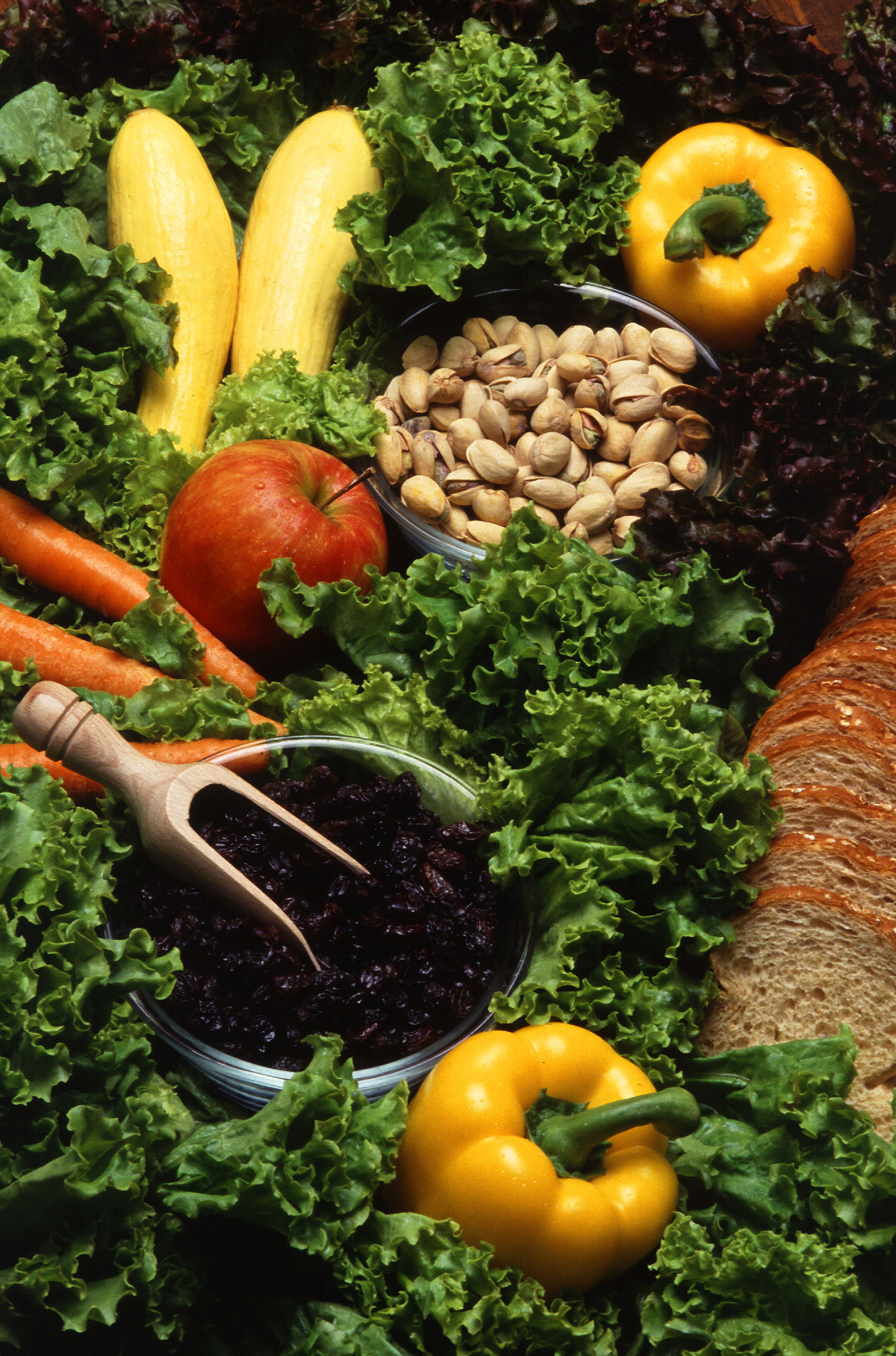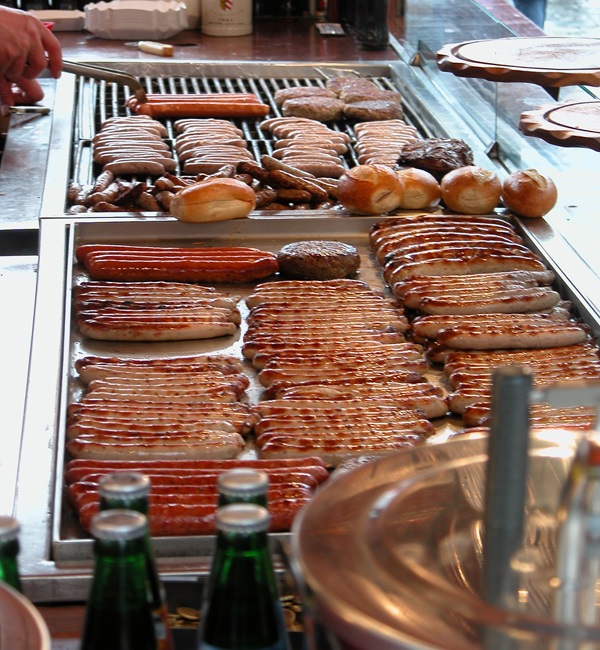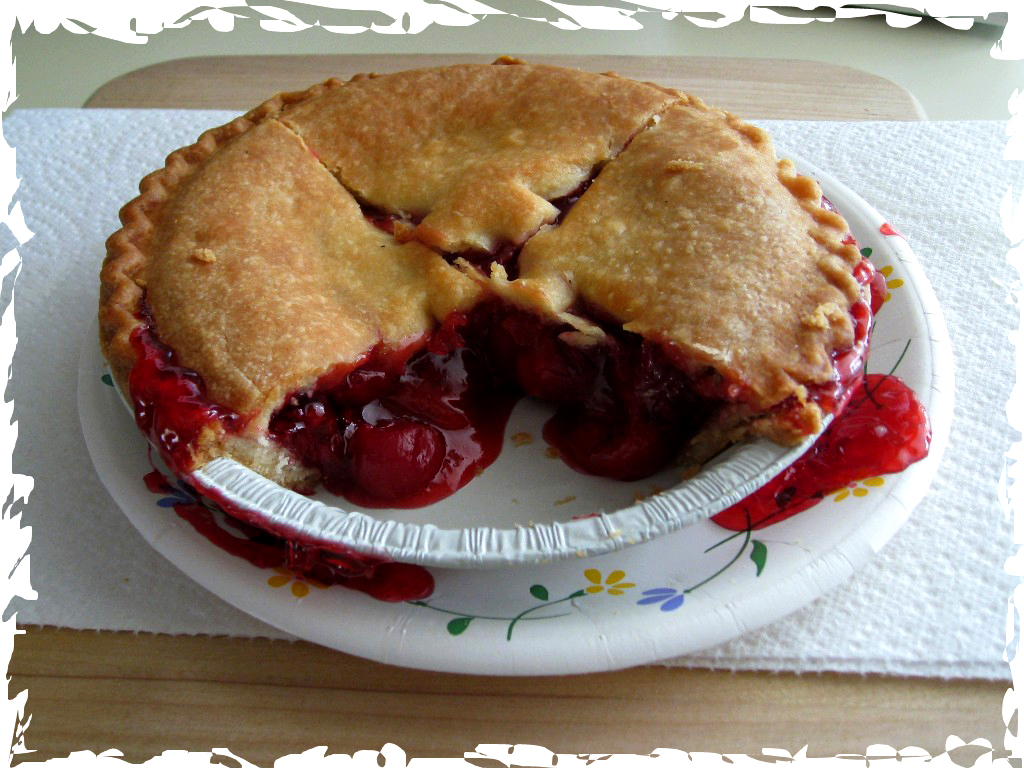|
Sour Cherry Soup
Sour cherry soup is a slightly sweet soup made with sour cream, sugar and whole fresh sour cherries, and served chilled. Originating in Hungarian cuisine, this soup is a summer delicacy in several European cuisines. The dish has been adopted by the Austrians, Poles, Slovaks, and Germans. Hungarian-Americans and Hungarian-Canadians brought the soup to North America.June Meyers, ''Authentic Hungarian Heirloom Recipes'' In Hungarian cuisine, sour cherry soup or ''meggyleves'' is a soup made from the fruits of the sour cherry tree (''Prunus cerasus''), and not from sweet cherries. The name is formed from 'sour cherries,' and meaning 'soup.' It is traditionally served as a dinner course, usually as either the appetizer, soup or dessert, on warm summer nights or for hot summer luncheons. The soup is cooked with whole sour cherries, including the pits. Sour cherry trees are numerous in Hungary, and the soup is a good example of the quintessentially Hungarian fusion of Eastern ... [...More Info...] [...Related Items...] OR: [Wikipedia] [Google] [Baidu] |
Hungary
Hungary ( hu, Magyarország ) is a landlocked country in Central Europe. Spanning of the Carpathian Basin, it is bordered by Slovakia to the north, Ukraine to the northeast, Romania to the east and southeast, Serbia to the south, Croatia and Slovenia to the southwest, and Austria to the west. Hungary has a population of nearly 9 million, mostly ethnic Hungarians and a significant Romani minority. Hungarian, the official language, is the world's most widely spoken Uralic language and among the few non-Indo-European languages widely spoken in Europe. Budapest is the country's capital and largest city; other major urban areas include Debrecen, Szeged, Miskolc, Pécs, and Győr. The territory of present-day Hungary has for centuries been a crossroads for various peoples, including Celts, Romans, Germanic tribes, Huns, West Slavs and the Avars. The foundation of the Hungarian state was established in the late 9th century AD with the conquest of the Carpathian Basin by Hungar ... [...More Info...] [...Related Items...] OR: [Wikipedia] [Google] [Baidu] |
Continental Europe
Continental Europe or mainland Europe is the contiguous continent of Europe, excluding its surrounding islands. It can also be referred to ambiguously as the European continent, – which can conversely mean the whole of Europe – and, by some, simply as the Continent. When Eurasia is regarded as a single continent, Europe is treated as a subcontinent, and called as European subcontinent. The old notion of Europe as a cultural term was centred on core Europe (''Kerneuropa''), the continental territory of the historical Carolingian Empire, corresponding to modern France, Italy, German-speaking Europe and the Benelux states (historical Austrasia). This historical core of "Carolingian Europe" was consciously invoked in the 1950s as the historical ethno-cultural basis for the prospective European integration (see also Multi-speed Europe). Usage The most common definition of Mainland Europe excludes these continental islands: the Greek Islands, Cyprus, Malta, Sicily, Sa ... [...More Info...] [...Related Items...] OR: [Wikipedia] [Google] [Baidu] |
Vegetarian Cuisine
Vegetarian cuisine is based on food that meets vegetarian standards by not including meat and animal tissue products (such as gelatin or animal-derived rennet). Lacto-ovo vegetarianism (the most common type of vegetarianism in the Western world) includes eggs and dairy products (such as milk and cheese without rennet). Lacto vegetarianism includes dairy products but not eggs, and ovo vegetarianism encompasses eggs but not dairy products. The strictest form of vegetarianism is veganism, which excludes all animal products, including dairy, honey, and some refined sugars if filtered and whitened with bone char. There are also partial vegetarians, such as pescetarians who eat fish but avoid other types of meat. There are a wide range of possible vegetarian foods, including some developed to particularly suit a vegetarian/vegan diet, either by filling the culinary niche where recipes would otherwise have meat, or by ensuring healthy intake of protein, B12 vitamin, and other nutrients ... [...More Info...] [...Related Items...] OR: [Wikipedia] [Google] [Baidu] |
Cherry Dishes
A cherry is the fruit of many plants of the genus ''Prunus'', and is a fleshy drupe (stone fruit). Commercial cherries are obtained from cultivars of several species, such as the sweet ''Prunus avium'' and the sour ''Prunus cerasus''. The name 'cherry' also refers to the cherry tree and its wood, and is sometimes applied to almonds and visually similar flowering trees in the genus ''Prunus'', as in " ornamental cherry" or "cherry blossom". Wild cherry may refer to any of the cherry species growing outside cultivation, although ''Prunus avium'' is often referred to specifically by the name "wild cherry" in the British Isles. Botany True cherries ''Prunus'' subg. ''Cerasus'' contains species that are typically called cherries. They are known as true cherries and distinguished by having a single winter bud per axil, by having the flowers in small corymbs or umbels of several together (occasionally solitary, e.g. ''P. serrula''; some species with short racemes, e.g. '' P. ... [...More Info...] [...Related Items...] OR: [Wikipedia] [Google] [Baidu] |
Cold Soups
Cold is the presence of low temperature, especially in the atmosphere. In common usage, cold is often a subjective perception. A lower bound to temperature is absolute zero, defined as 0.00K on the Kelvin scale, an absolute thermodynamic temperature scale. This corresponds to on the Celsius scale, on the Fahrenheit scale, and on the Rankine scale. Since temperature relates to the thermal energy held by an object or a sample of matter, which is the kinetic energy of the random motion of the particle constituents of matter, an object will have less thermal energy when it is colder and more when it is hotter. If it were possible to cool a system to absolute zero, all motion of the particles in a sample of matter would cease and they would be at complete rest in the classical sense. The object could be described as having zero thermal energy. Microscopically in the description of quantum mechanics, however, matter still has zero-point energy even at absolute zero, because ... [...More Info...] [...Related Items...] OR: [Wikipedia] [Google] [Baidu] |
Slovak Soups
Slovak may refer to: * Something from, related to, or belonging to Slovakia (''Slovenská republika'') * Slovaks, a Western Slavic ethnic group * Slovak language, an Indo-European language that belongs to the West Slavic languages * Slovak, Arkansas, United States See also * Slovák, a surname * Slovák, the official newspaper of the Slovak People's Party Hlinka's Slovak People's Party ( sk, Hlinkova slovenská ľudová strana), also known as the Slovak People's Party (, SĽS) or the Hlinka Party, was a far-right clerico-fascist political party with a strong Catholic fundamentalist and authorit ... * {{disambiguation, geo Language and nationality disambiguation pages ... [...More Info...] [...Related Items...] OR: [Wikipedia] [Google] [Baidu] |
Slovak Cuisine
Slovak cuisine varies slightly from region to region across Slovakia. It was influenced by the traditional cuisine of its neighbours and it influenced them as well. The origins of traditional Slovak cuisine can be traced to times when the majority of the population lived self-sufficiently in villages, with very limited food imports and exports and with no modern means of food preservation or processing. This gave rise to a cuisine heavily dependent on a number of staple foods that could stand the hot summers and cold winters. These included wheat, potatoes, milk and milk products, pork meat, sauerkraut and onion. To a lesser degree beef, poultry, lamb and goat, eggs, a few other local vegetables, fruit and wild mushrooms were traditionally eaten. All these were usually produced and processed by families themselves with some local trade at the country markets. Wheat was ground, and bread, dumplings and noodles were made from it. Potatoes were mostly boiled or processed into potat ... [...More Info...] [...Related Items...] OR: [Wikipedia] [Google] [Baidu] |
German Cuisine
The cuisine of Germany () is made up of many different local or regional cuisines, reflecting the country's federal history. Germany itself is part of the larger cultural region of Central Europe, sharing many culinary traditions with neighbouring countries such as Poland and the Czech Republic. Southern regions, like Bavaria and Swabia, share dishes with Austrian cuisine and parts of Swiss cuisine. The Michelin Guide of 2015 awarded a three-star ranking (the highest designation) to 11 restaurants in Germany, while 38 more received two-star rankings and 233 one-star rankings. , Germany had the fourth-highest number of Michelin three-star restaurants in the world, after Japan, France, and the United States. Hot foods Meat The average annual meat consumption is per person. The most common varieties are pork, poultry and beef. Other varieties of meat are widely available, but are considered to be insignificant. Source: Statista.com, 2017 Meat is usually braised; fried dish ... [...More Info...] [...Related Items...] OR: [Wikipedia] [Google] [Baidu] |
Austrian Cuisine
Austrian cuisine () is a style of cuisine native to Austria and composed of influences from Central Europe and throughout the former Austria-Hungary, Austro-Hungarian Empire. Austrian cuisine is most often associated with Viennese cuisine, but there are significant regional variations. Mealtimes Breakfast is of the "continental" type, usually consisting of Kaiser roll, bread rolls with either jam or cold meats and cheese, accompanied by coffee, tea or juice. The midday meal was traditionally the main meal of the day, but in modern times as Austrians work longer hours further from home this is no longer the case. The main meal is now often taken in the evening. A mid-morning or mid-afternoon snack of a slice of bread topped with cheese or ham is referred to as a ''Jause''; a more substantial version akin to a British "ploughman's lunch" is called a ''Brettljause'' after the wooden board on which it is traditionally served. Popular dishes of Vienna * ''Rindsuppe'' (beef s ... [...More Info...] [...Related Items...] OR: [Wikipedia] [Google] [Baidu] |
Hungarian Desserts
Hungarian may refer to: * Hungary, a country in Central Europe * Kingdom of Hungary, state of Hungary, existing between 1000 and 1946 * Hungarians, ethnic groups in Hungary * Hungarian algorithm, a polynomial time algorithm for solving the assignment problem * Hungarian language, a Finno-Ugric language spoken in Hungary and all neighbouring countries * Hungarian notation, a naming convention in computer programming * Hungarian cuisine Hungarian or Magyar cuisine is the cuisine characteristic of the nation of Hungary and its primary ethnic group, the Magyars. Traditional Hungarian dishes are primarily based on meats, seasonal vegetables, fruits, bread, and dairy products. ..., the cuisine of Hungary and the Hungarians See also * * {{disambiguation Language and nationality disambiguation pages ... [...More Info...] [...Related Items...] OR: [Wikipedia] [Google] [Baidu] |
List Of Soups
This is a list of notable soups. Soups have been made since Ancient history, ancient times. Some soups are served with large chunks of meat or vegetables left in the liquid, while others are served as a broth. A broth is a flavored liquid usually derived from boiling a type of meat with bone, a spice mix, or a vegetable mix for a period of time in a Stock (food), stock. A potage is a category of thick soups, stews, or porridges, in some of which meat and vegetables are boiled together with water until they form a thick mush. Bisque (food), Bisques are heavy cream soups traditionally prepared with shellfish, but can be made with any type of seafood or other base ingredients. Cream soups are dairy based soups. Although they may be consumed on their own, or with a meal, the canned, condensed form of cream soup is sometimes used as a quick sauce in a variety of meat and pasta convenience food dishes, such as casseroles. Similar to bisques, chowders are thick soups usually containi ... [...More Info...] [...Related Items...] OR: [Wikipedia] [Google] [Baidu] |
List Of Cherry Dishes
This is a list of notable cherry dishes and foods that are prepared using cherries as a primary ingredient. Cherry dishes and foods * Black Forest gateau – a chocolate sponge cake with a rich cherry filling based on the German dessert ''Schwarzwälder Kirschtorte'', literally "Black Forest Cherry-torte". * Cherpumple – a novelty dish where several different flavor pies are baked inside of several different flavors of cake and stacked together. According to the Cherpumple's creator, pop culture humorist Charles Phoenix, "Cherpumple is short for cherry, pumpkin and apple pie. The apple pie is baked in spice cake, the pumpkin in yellow and the cherry in white." * Cherry Blossom – a chocolate bar in Canada produced by Hershey Canada Inc. Hershey used to produce it at its Canadian manufacturing facility in Smiths Falls, Ontario. It is now produced in Mexico. * Cherry cake – a traditional British cake that consists of glacé cherries evenly suspended within a Madeira spo ... [...More Info...] [...Related Items...] OR: [Wikipedia] [Google] [Baidu] |

.jpg)




